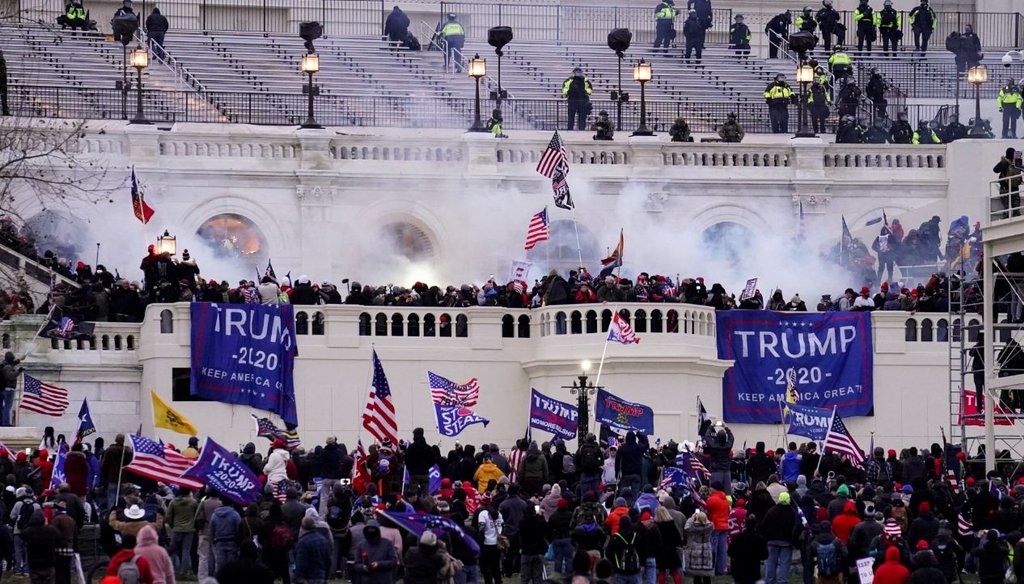Stand up for the facts!
Our only agenda is to publish the truth so you can be an informed participant in democracy.
We need your help.
I would like to contribute

The storming of the Capitol on Jan. 6, 2021. (AP)
If Your Time is short
• After studying the events of Jan. 6, the Coup D’etat Project at the University of Illinois’ Cline Center for Advanced Social Research has determined that the storming of the U.S. Capitol qualifies as an attempted coup.
• The center’s evaluation found that the Capitol rioters posed a credible threat to the power of the legislative branch, that the attackers were trying to change who controls the government, and that the assault included at least some elements of advance organization.
On Jan. 6, we published an article about the storming of the U.S. Capitol and the baseless accusations about the presidential election results that led up to it. In the article, we asked whether it was accurate to call it a coup. But because the details of that day’s events were still emerging, we did not draw a firm conclusion.
Now, an academic center that was the major resource for our analysis — the Coup D’etat Project at the University of Illinois’ Cline Center for Advanced Social Research— has made a determination that had not been made at the time we wrote our initial article.
Specifically, the group has decided that the events of Jan. 6 do fit the definition of an "attempted dissident coup" under the group’s taxonomy.
The storming of the Capitol "was an attempted coup d’état: an organized, illegal attempt to intervene in the presidential transition by displacing the power of the Congress to certify the election," the center announced on Jan. 27.
A coup is shorthand for "coup d’etat," a French term that means the overthrow of the government. The key element of a coup is that it is carried out beyond the bounds of legality.
Sign up for PolitiFact texts
Specifically, in 2013, the Cline Center defined a coup d'état as "the sudden and irregular (i.e., illegal or extra-legal) removal, or displacement, of the executive authority of an independent government."
The group further separates coups into three categories. Coups that are planned but thwarted before being undertaken are coup conspiracies. If actions are taken but are unsuccessful, it is considered an attempted coup. And If the coup achieves its goals, it is considered a successful coup.
Since the center framed that definition, it worked to document every coup, attempted coup, and coup conspiracy anywhere in the world since 1945. The group’s database currently includes 426 realized coups, 336 coup attempts, and 181 coup conspiracies.
The Jan. 6 incident at the U.S. Capitol qualified as an attempted coup, the Cline Center decided.
It becomes only the second entry for the United States in the Cline Center's database. The one previous entry was a dissident coup conspiracy in 1948, involving members of the Communist Party of the United States who plotted to violently overthrow the U.S. government. Their convictions were upheld by the Supreme Court in 1951.
The determination was made by human analysts, rather than artificial intelligence algorithms, Cline Center director Scott Althaus told PolitiFact.
Althaus said the center assembled a team of six researchers familiar with the criteria who reviewed a range of publicly available information sources. The six researchers made independent reviews, then compared notes with each other. The determination required unanimous consensus across all six researchers.
They concluded that the events of Jan. 6 included three other broad characteristics of a coup.
First, the center said, one or more persons posed a credible threat to the power of the legislative branch to determine national policy. On Jan. 6, thousands of people advanced on the Capitol or entered it, a big enough safety concern that lawmakers had to stop conducting constitutionally mandated business in order to be evacuated from the building.
Second, the attackers were trying to change who controls the government. "The ‘Save America March’ rally that immediately preceded the attack on the U.S. Capitol building was thematically focused on changing the outcome of the 2020 U.S. presidential election," the center wrote.
And third, the assault on the Capitol included at least some elements of advance organization, the center concluded.
"Those who stormed the U.S. Capitol building — as well as those who merely joined in the peaceful protests that preceded it — included a diverse mix of groups and unaffiliated individuals," the center wrote. "But one or more of the groups within the ranks of those who entered the Capitol Building had carefully planned, equipped, and organized themselves for violent action."
Having determined that it was an attempted coup, the center further classified the events of Jan. 6 as a "dissident attempted coup," because "the groups and individuals known to have organized and planned this coup attempt fall clearly into the category of ‘dissidents.’"
Under the center’s definition, "dissidents" refers to a "small group of discontents that can include former government officials, religious leaders, business owners or civilians."
The center left open the possibility that additional revelations, such as those in court, could layer another classification onto this "dissident" coup — one that encompasses sitting government officials.
"If further investigation were to reveal clear evidence of executive branch involvement, then the events of Jan. 6 would also be considered an attempted auto-coup," the center wrote.
The center’s definition of an auto-coup is when "the incumbent chief executive uses illegal or extra-legal means to assume extraordinary powers, seize the power of other branches of government, or render powerless other components of the government such as the legislature or judiciary."
Our Sources
University of Illinois Cline Center, "It Was an Attempted Coup: The Cline Center’s Coup D’état Project Categorizes the January 6, 2021 Assault on the US Capitol," Jan. 27, 2021
Britannica.com, "Dennis v. United States," accessed Jan. 29, 2021
PolitiFact, "Is this a coup? Here’s some history and context to help you decide," Jan. 6, 2021
Email interview with Scott Althaus, director of the University of Illinois’ Cline Center for Advanced Social Research, Jan. 29, 2021




































